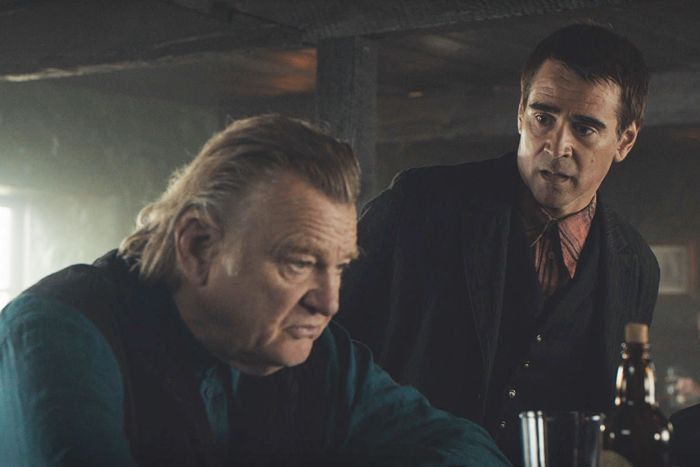
The Banshees of Inisherin is a spectacular breakup movie, in that it’s about how breakups are impossible when you live in an insular community where there’s nothing much to do but shoot the shit. Shooting the shit is pretty much all Pádraic Súilleabháin (Colin Farrell) and Colm Doherty (Brendan Gleeson) seem to have done for years, with a standing date at two o’clock at the pub where they appear to have spent the bulk of their lives on the fictional Irish island of the title. But when the film begins, Colm has decided to disturb the universe. When Pádraic comes calling around Colm’s small seaside home at the usual hour, the man he’d always thought of as his best friend refuses to answer the door or acknowledge him through the window. There was no disagreement to cause this schism. “I just don’t like you no more,” Colm says flatly when Pádraic eventually tracks him down. Pádraic has trouble even comprehending the new status quo, and it’s hard to blame him. Much of the black comedy of The Banshees of Inisherin comes from the absurdity of someone making a point of sitting on the other side of the pub now, though in a world as constrained as that of the characters, this amounts to an act of genuine, painful betrayal.
The last time Farrell and Gleeson were in a film together, they were garrulous hit men in Martin McDonagh’s 2008 directorial debut In Bruges, and it’s McDonagh who’s brought them together again here for a feature that’s less driven to show off, and better for it. It’s the best thing McDonagh has ever done for the screen, a work of deep melancholy and deeper spite. It was conceived of and written for the screen, but McDonagh will always be a playwright first, and it’s still driven by long exchanges of the chewy, profane, philosophical dialogue that is his signature. It’s in many ways a film about talking, and whether time spent idling in the company of others is the basic stuff of life or a distraction from what’s important. Pádraic begins as the more sympathetic figure, but Farrell plays his nattering persistence and sheer obstinance in the face of any change so well that you start to understand why someone might want to get away from him. Gleeson, his great head bowed as though under the weight of an enormous crown, exudes the iron-willed determination in Colm to have his own way. He wants to focus on the music he sees as his only chance to leave a mark on the world, but his will to be left alone is so strong that he vows that he’ll start cutting fingers off his fiddling hand every time Pádraic comes to see him — and means it.
The Banshees of Inisherin takes place in 1923, which has bearing mostly because the Irish Civil War is in its final days, and the booms of cannon fire are occasionally heard from the nearby mainland. The conflict matters little to the residents of the island — the local constable, a puffed-up bully named Peadar Kearney (Gary Lydon), talks enthusiastically about taking a paid gig to help with executions over there for the day while being unable to keep straight whom he’d be killing, and on whose behalf. But McDonagh implies a greater resonance between the not-so-distant fighting and the personal conflict at the center of his film, as though the inability in both Pádraic and Colm to de-escalate were indicative of some shared cultural character, a willingness to dig down and hold on and not let past hurts go. Colm, who’s been nursing an existential melancholy (“How’s the despair?” the priest asks him during confession), seems fully capable of displaying a dark side. But it’s Pádraic — a simpler man (there’s some debate as to whether he’s “dull” or “nice,” as though these qualities are mutually exclusive) who’d been content with his pints, the cottage he shares with his sister Siobhán (Kerry Condon), and the miniature donkey he keeps letting inside despite Siobhán’s protestations — who turns out to have an apocalyptic streak.
The Banshees of Inisherin is like watching two cars slowly set out on a collision course ending in a crash that would be easily averted if one would just give way. But it’s also a caustic masterstroke of anti-romanticism, a counter to every starry-eyed screen portrait (often made by an American) of rural Ireland as a verdant sanctuary of close traditions, quirky characters, and a more authentic way of life. The Banshees of Inisherin begins by gliding its camera over a brilliantly green landscape checkered by stone walls, and then shows a rainbow lurking behind Pádraic as he goes on his way. But life in Inisherin is so circumscribed and stifling that it seems to be destroying all the characters from within — not just Pádraic and Colm and their petty but ever-intensifying duel. Siobhán, a bookish spinster, has been living an existence of intense loneliness, while Dominic (a tragicomic Barry Keoghan), Peadar’s semi-feral and regularly beaten son, is a figure of despair in the guise of a clown. There’s no sense of intimacy to the closeness of the locals, just pettiness in their grudges and claustrophobia in the way the store-owner at one end of the island barks out demands for news from the other side. The main thing rooting them to where they are isn’t connection, but obstinance. The war that erupts between Pádraic and Colm is fueled not just by the pair’s respective intractability, but by an understanding that it gives them a purpose and something to do.
More Movie Reviews
- The Accountant 2 Can Not Be Taken Seriously
- Another Simple Favor Is So Fun, Until It Gets So Dumb
- Errol Morris Has Been Sucked Into the Gaping Maw of True Crime


